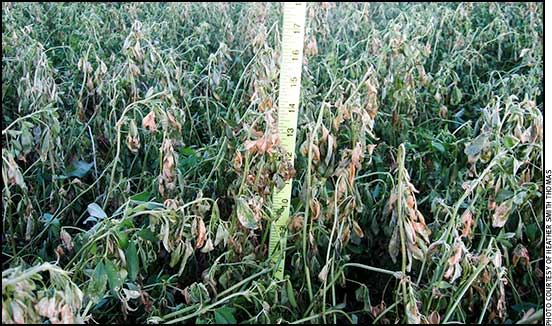HEALTH & NUTRITION...

Avoid Bloat on Fall Pastures
A freeze can make pastures deadly if proper safeguards aren’t taken.
Bloat is sometimes a serious emergency, and fall pastures may be risky under certain conditions. Dick Fredrickson, staff veterinarian for J.R. Simplot Co., Santa Clara, Calif., says alfalfa is particularly deadly for the first few days after a hard frost.
“Freezing breaks down cell walls in the leaves, and this releases all the protein and carbohydrates all at once,” he explains.
This puts a big load of soluble protein in the rumen immediately, rather than the animal digesting it and breaking it down gradually. Rumen microbes can’t digest it in an orderly fashion. The fine particles and overload of soluble proteins creates excess gas in a froth that tends to rise above the valve to the esophagus. The animal cannot belch to get rid of the gas. Read more.
Using Drought-stressed Corn for Silage
Expert offers tips for ensiling drought-stressed forage.
It is estimated that about 3% of the U.S. corn crop experienced drought conditions this year. If plants were stressed in the field, there will likely be challenges ensiling and feeding the crop, too.
“First off, nitrates can accumulate when corn is under drought stress, and high levels of nitrates can be harmful to animal health,” says Renato Schmidt, technical services–forage, Lallemand Animal Nutrition. “We can still produce good silage from drought-stressed corn as long as the crop is harvested correctly, ensiled well and carefully stored.”
Don’t take high-nitrate corn lightly, Schmidt warns. Even subclinical nitrate toxicity can result in decreased intakes, gains and production; decreased conception rates, embryonic death, and, occasionally, abortions. Read more.
Reminders for Cattle Transport
Follow these tips to make transport safer for both cattle and people.
An accident involving a cattle truck in Indiana July 11 shed light on how quickly the beef industry hits the media spotlight –– in this specific case, creating a less-than-desirable outcome for agriculture.
As summer heat and drought conditions push potential weaning dates ahead on the calendar, many cattlemen may start to feel crunched for time and become overwhelmed by the management decisions they need to make. In times of stressful situations, haste can make waste, so take time to slow down and ensure the safety of people and cattle.
Here are a few reminders to plan for successful handling experiences each time cattle are transported. Read more.
Feeding for Prevention
Probiotics and prebiotics set cattle up for success.
The saying “the best defense is a good offense” holds true even for livestock producers. Preventing losses in production and reducing treatment costs is a winning strategy, says Angel Aguilar, technical service manager for Lallemand Animal Nutrition.
“We know one of the most important pillars for production and profitability is ensuring each animal has a good nutritional status,” Aguilar says. “This sets the stage for everything — from vaccinations to breeding programs — to work correctly.”
After getting the fundamentals right, producers can make their rations work even harder by adding proven probiotics and prebiotics for additional gains in health and productivity. Read more.
Battling Flies that Bother Beef Cattle
New tools available to combat pests.
The battle against flies is constant during warm weather. Best control is obtained with a combination of tactics. Nancy Hinkle, professor of veterinary entomology at the University of Georgia, says the cattle industry is, unfortunately, very dependent on insecticides. Now we are faced with new generations of flies that have become resistant to these weapons.
We need new methodology, especially for horn flies, she says.
“Across North America, horn flies are still the number one pest. We do have one new ear tag using tolfenpyrad as the insecticide,” she says. “When we tested it, we were impressed because it kept fly numbers below 50 per head for a full two months. The control animals had 200 to 300 flies per animal.” Read more.
Get Weaned Calves Straightened Out More Quickly
Decrease stress to help out calves.
Sometimes the biggest challenges to livestock production are out of our control, but as producers we still look for ways to work around those obstacles. That is the case for one cattle operation in Northeast Louisiana where heat and humidity are at a peak as they approach weaning time.
“The humidity down here is the worst thing we fight,” said Colby Daugherty, manager at J&S Cattle at Bastrop, La.
Due to the operation’s size and scope –– managing more than 2,500 mama cows across five parishes –– they wean all calves in one group, starting in early September. Ideally, most of those calves will weigh between 600-700 pounds (lb.), but like most operations, there are always calves that are a little behind, and they will wean some that weigh as little as 400 lb. Read more.
Cattle Diseases: Common Conditions/Terms
Click here for a list of common conditions and terms related to beef cattle diseases, such as anaplasmosis, brucellosis, BVD, E. coli, IBR and others.
[Click here to go to the top of the page.]






